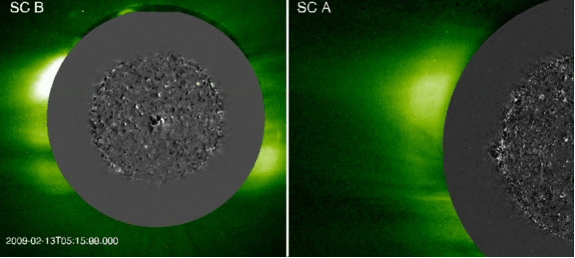Solar Tsunamis Are Real, NASA Says

Incredibly powerful waves of plasma rippling across thesurface of the sun and dubbed "solar tsunamis" were first observedyears ago, but were thought to be an optical illusion. Scientists have nowconfirmed, though, that they are really real.
When scientists first saw the phenomenon, it was hard tobelieve that a towering wave of hot plasma was actually racing along the sun'ssurface. One of the waves rose up higher than the diameter of Earth and rippledout from a central point in a circular pattern millions of miles wide, like agargantuan pattern of waves created by a pebble dropped in a pond.
Skeptical observers suggested it might be a shadow of somekind ? a trick of the eye. But new observations from NASA's STEREO (SolarTerrestrial Relations Observatory) spacecraft are telling researchers that thiscontroversial phenomenon isn't an illusion.
This week, NASA released a remarkable videoof a solar tsunami.
"Now we know," said Joe Gurman of the SolarPhysics Lab at NASA's Goddard Space Flight Center in Greenbelt, Md. "Solartsunamis are real."
Reality confirmed
The twin STEREO spacecraft confirmed their reality in imagescaptured in February when sunspot 11012 unexpectedly erupted. The blast hurleda billion-ton cloud of gas (a coronal massejection, or "CME") into space and sent a tsunami racing alongthe sun's surface.
Get the Space.com Newsletter
Breaking space news, the latest updates on rocket launches, skywatching events and more!
STEREO recorded the wave from two positions separated by 90degrees, giving researchers an unprecedented view of the event.
"It was definitely a wave," said SpirosPatsourakos of George Mason University in Virginia and lead author of a paperreporting the finding in the Astrophysical Journal Letters. "Not a wave ofwater," he adds, "but a giant wave of hot plasma and magnetism."
The technical name is "fast-mode magnetohydrodynamicalwave" ? or "MHD wave" for short. The one STEREO saw reared upabout 62,000 miles (100,000 km) high, and raced outward at 560,000 mph (250km/s) packing as much energy as 2,400 megatons of TNT.
Solar tsunamis were discoveredback in 1997 by the Solar and Heliospheric Observatory (SOHO). In May ofthat year, a CME blasted up from an active region on the sun's surface, and SOHO recorded a tsunami rippling away from the blast site.
"We wondered," Gurman recalled, "is that awave ? or just a shadow of the CME overhead?"
Stereo view
SOHO's single point of view was not enough to answer thequestion?neither for that first wave nor for many similar events recorded by SOHO in years that followed, until STEREO launched in 2006. The mission uses two spacecraft? one orbiting the sun ahead of the Earth, the other behind it ? to get,literally, a stereo view of the sun.
"We've seen the waves reflected by coronal holes(magnetic holes in the sun's atmosphere)," Vourlidas said. "And thereis a wonderful movie of a solar prominence oscillating after it gets hit by a wave.We call it the 'dancing prominence.'"
Solar tsunamis pose no direct threat to Earth. Nevertheless,they are important to study, scientists say.
"We can use them to diagnose conditions on thesun," Gurman said. "By watching how the waves propagate and bounceoff things, we can gather information about the sun's lower atmosphereavailable in no other way."
"Tsunami waves can also improve our forecasting ofspace weather," Vourlidas added, "Like a bull-eye, they 'mark thespot' where an eruption takes place. Pinpointing the blast site can help usanticipate when a CME or radiation storm will reach Earth."
- Video ? Solar Tsunami Spotted
- The Worst Weather in the Solar System
- Images: Sun Storms
Join our Space Forums to keep talking space on the latest missions, night sky and more! And if you have a news tip, correction or comment, let us know at: community@space.com.

Space.com is the premier source of space exploration, innovation and astronomy news, chronicling (and celebrating) humanity's ongoing expansion across the final frontier. Originally founded in 1999, Space.com is, and always has been, the passion of writers and editors who are space fans and also trained journalists. Our current news team consists of Editor-in-Chief Tariq Malik; Editor Hanneke Weitering, Senior Space Writer Mike Wall; Senior Writer Meghan Bartels; Senior Writer Chelsea Gohd, Senior Writer Tereza Pultarova and Staff Writer Alexander Cox, focusing on e-commerce. Senior Producer Steve Spaleta oversees our space videos, with Diana Whitcroft as our Social Media Editor.









